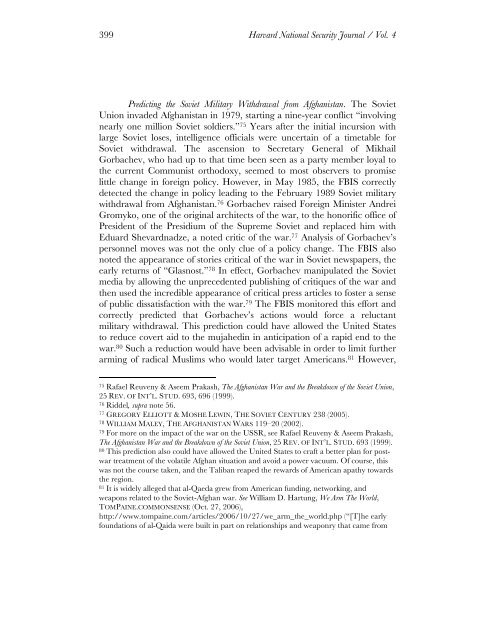Vo.4-Moshirnia-Final
Vo.4-Moshirnia-Final
Vo.4-Moshirnia-Final
You also want an ePaper? Increase the reach of your titles
YUMPU automatically turns print PDFs into web optimized ePapers that Google loves.
399 Harvard National Security Journal / Vol. 4<br />
Predicting the Soviet Military Withdrawal from Afghanistan. The Soviet<br />
Union invaded Afghanistan in 1979, starting a nine-year conflict “involving<br />
nearly one million Soviet soldiers.” 75 Years after the initial incursion with<br />
large Soviet loses, intelligence officials were uncertain of a timetable for<br />
Soviet withdrawal. The ascension to Secretary General of Mikhail<br />
Gorbachev, who had up to that time been seen as a party member loyal to<br />
the current Communist orthodoxy, seemed to most observers to promise<br />
little change in foreign policy. However, in May 1985, the FBIS correctly<br />
detected the change in policy leading to the February 1989 Soviet military<br />
withdrawal from Afghanistan. 76 Gorbachev raised Foreign Minister Andrei<br />
Gromyko, one of the original architects of the war, to the honorific office of<br />
President of the Presidium of the Supreme Soviet and replaced him with<br />
Eduard Shevardnadze, a noted critic of the war. 77 Analysis of Gorbachev’s<br />
personnel moves was not the only clue of a policy change. The FBIS also<br />
noted the appearance of stories critical of the war in Soviet newspapers, the<br />
early returns of “Glasnost.” 78 In effect, Gorbachev manipulated the Soviet<br />
media by allowing the unprecedented publishing of critiques of the war and<br />
then used the incredible appearance of critical press articles to foster a sense<br />
of public dissatisfaction with the war. 79 The FBIS monitored this effort and<br />
correctly predicted that Gorbachev’s actions would force a reluctant<br />
military withdrawal. This prediction could have allowed the United States<br />
to reduce covert aid to the mujahedin in anticipation of a rapid end to the<br />
war. 80 Such a reduction would have been advisable in order to limit further<br />
arming of radical Muslims who would later target Americans. 81 However,<br />
75 Rafael Reuveny & Aseem Prakash, The Afghanistan War and the Breakdown of the Soviet Union,<br />
25 REV. OF INT’L. STUD. 693, 696 (1999).<br />
76 Riddel, supra note 56.<br />
77 GREGORY ELLIOTT & MOSHE LEWIN, THE SOVIET CENTURY 238 (2005).<br />
78 WILLIAM MALEY, THE AFGHANISTAN WARS 119–20 (2002).<br />
79 For more on the impact of the war on the USSR, see Rafael Reuveny & Aseem Prakash,<br />
The Afghanistan War and the Breakdown of the Soviet Union, 25 REV. OF INT’L. STUD. 693 (1999).<br />
80 This prediction also could have allowed the United States to craft a better plan for postwar<br />
treatment of the volatile Afghan situation and avoid a power vacuum. Of course, this<br />
was not the course taken, and the Taliban reaped the rewards of American apathy towards<br />
the region.<br />
81 It is widely alleged that al-Qaeda grew from American funding, networking, and<br />
weapons related to the Soviet-Afghan war. See William D. Hartung, We Arm The World,<br />
TOMPAINE.COMMONSENSE (Oct. 27, 2006),<br />
http://www.tompaine.com/articles/2006/10/27/we_arm_the_world.php (“[T]he early<br />
foundations of al-Qaida were built in part on relationships and weaponry that came from
















